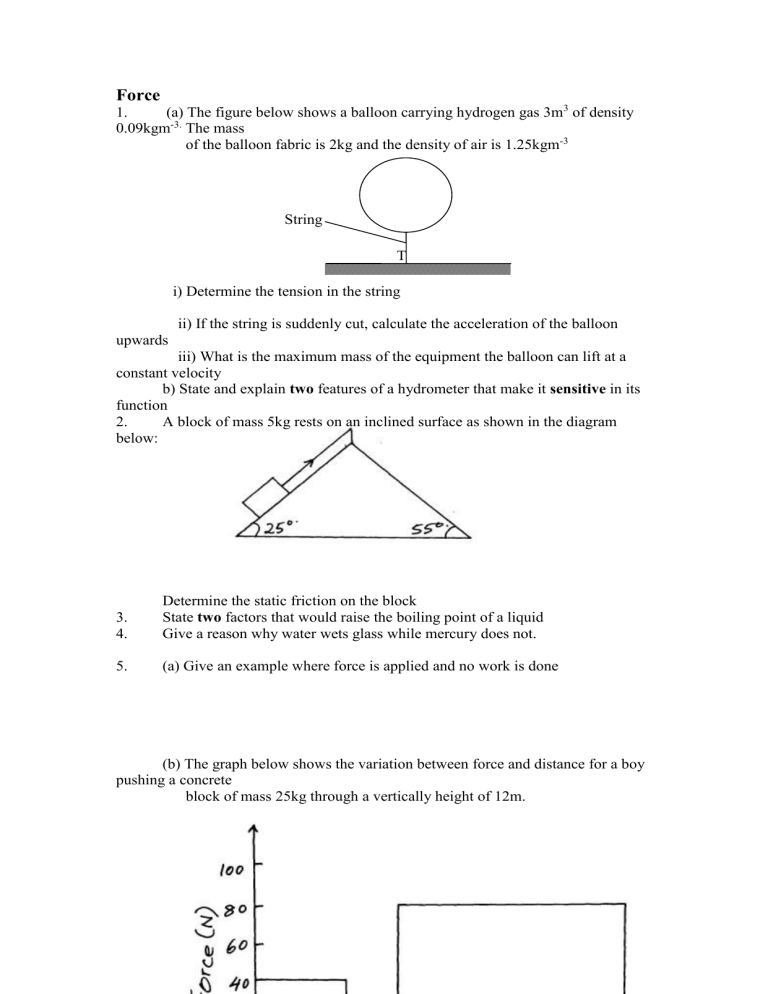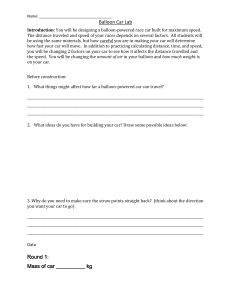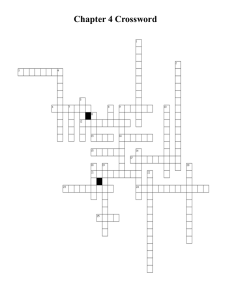
Force 1. (a) The figure below shows a balloon carrying hydrogen gas 3m3 of density 0.09kgm-3. The mass of the balloon fabric is 2kg and the density of air is 1.25kgm-3 String T i) Determine the tension in the string ii) If the string is suddenly cut, calculate the acceleration of the balloon upwards iii) What is the maximum mass of the equipment the balloon can lift at a constant velocity b) State and explain two features of a hydrometer that make it sensitive in its function 2. A block of mass 5kg rests on an inclined surface as shown in the diagram below: 3. 4. Determine the static friction on the block State two factors that would raise the boiling point of a liquid Give a reason why water wets glass while mercury does not. 5. (a) Give an example where force is applied and no work is done (b) The graph below shows the variation between force and distance for a boy pushing a concrete block of mass 25kg through a vertically height of 12m. (i) Determine the total work done by the boy within 70m (ii) How much energy is wasted? (iii) Give an account for the energy wasted 6. State the principle of moments. 7. State any two factors that affect the earths gravitational force 8. Figure 3 below shows a wire loop with a string that has been dipped into soap solution. Fig. 3 i) Sketch a similar diagram to show the observed effect if the soap film is punctured at X ii) Explain the observations made in (i) above 9. Figure 2 shows two glass tubes of different size of bore, dipped in a glass beaker half full of water fig. 2 Complete the diagram to show how water will rise up in the two glass tubes 10. (a) State the conditions necessary for the law of conservation of linear momentum to hold (b) The diagram figure 13 below shows a steel ball bearing gently dipped in a viscous liquid contained in a tall cylinder fig. 13 (i) Name giving their directions the forces acting on the ball bearing as it moves down the cylinder (ii) The graph in figure 14 below shows the velocity-time graph (a) for the motion of the above ball fig. 14. On the same diagram, draw the graph (b) for a steel ball of smaller radius in the same liquid (iii) Explain the difference in the two graphs (a) and (b) (c) (i) A breakdown truck tows a car of mass 1000kg along a level road, and accelerates at 0.5m/s2. What is the tension in the tow line (ii) If the tow line in (c)(i) above breaks when the car reaches a speed of 36km/h, how far will the car travel before coming to rest if the breaking force is 2000N? 11. Explain why it is easier to ride a bicycle round a bend on a road if the surface is dry than when it is wet 12. Give one difference between limiting and dynamic forces of friction 13. Mercury on a clean glass slide collects into small spherical balls as shown in figure 2 below. Explain why Drops of mercury Clean glass slide 14. The figure 7 below shows two blocks of masses M1=1.5kg and M2 = 2.0kg which are in contact on a frictionless table fig. 7 A force F=7N acts on the bodies, determine the force on mass M2 15. glass State one factor that determines the depth to which mercury is depressed in a capillary tube. Force 1. The mass of the balloon fabric is 2kg and the density of air is 1.25kgm-3 mass of gas = 3X 0.9 kg kj = 0.27kg Total weight of balloon 10 X (2+ 027) = 22.7 Mass of air displaced. 1.25 X 3 = 3.75 Wt of air displaced 1.25 X 3 = 3.75N Tension = U W = 37.5N 22.7 N= 14 .8N i) Determine the tension in the string ii) If the string is suddenly cut, calculate the acceleration of the balloon upwards F = M 14.8 = m 14.8 = 2.27 2.27 m/s2 where m = 2.27 kg iii) What is the maximum mass of the equipment the balloon can lift up at a constant velocity maximum mass that the balloon can carry 14.8.N = 1.48kg 10N/kg c) State and explain two features of a hydrometer that make it sensitive in its function. The stem is thin. This makes the hydrometer sensitive such that a small change in density of liquid causes a large change on the stem. The bulb is large to make it float. The bulb is heavy to make it float a upright. 2. Static friction = mg sin = 5x 10sin25o = 5 x 10 x 0.4226= 21.13 3. - Increase in pressure - Addition of impurities 4. In water the cohesion forces between molecules water molecules is lower than the adhesive forces between water and glass. Which in mercury the cohesion forces between mercury molecules are greater than adhesive forces between mercury and glass. 5. a) Pushing a wall/anything that does not more when force is applied (b) (i) work done = Area under the graph = (40x20) + (20 x 10) = (80 x 40) = 800 + 200 + 3200 = 4200J (ii) work done = mgh = 25 x 10 x 12 = 3000J Energy wasted = (4200 3000)J = 1200J (iii) Friction force between the surfaces. Some work is done against friction 6. For a system in equilibrium the sum of clockwise moments about a point is equal to the sum of anticlockwise moments about the same point; 7. the latitude of the location 1 - The altitude of the location 8. i) X String YY ii) When side x of the film is broken, surface tension acts only on one side Y of the film; 1 surface tension of the film tends to make the surface area to be minimum 1 hence it pulls the string to make a smooth curve 9. Explanation- Water rises higher in a glass tube with narrow bore than the one with larger bore because more water molecules get in contact with glass molecules because of greater adhesive force between glass molecules and water molecules, then in the one with large bore. 10. (a) If no external force acts on the system of colliding bodies (b) (i) Visersity acting1 upwards- each forces - Upthrust acting upwards and correct directions - Weight acting downwards (ii) Correct curve and position1 above graph (a) 1 Hence small ball has low (iii) Viscosity if directly proportional to radius. friction leading to 1 higher speed of fall and higher terminal velocity (c) (i) Tension = force on car F = ma 1 = 1000 x 0.5 = 500N 1 (ii) Retardation = F = 2000 =1 2m/ss m 1000 n = 36 x 1000 = 10m/s 60 x 60 1 V2 = u2 + 2as O = (10)2 + 2(-2)s 1 S = 100 = 25m 1 4 11. When the surface is dry, the frictional force between the tyres and the surface is higher 1 than when wet, hence there is less skidding 12. Limiting friction Friction between objects just before moving Dynamic friction Friction between surfaces in relative motion 13. Cohesive force between mercury molecules is stronger than the adhesive force between mercury molecules and the glass side; (correct differentiation of forces) (2mks) 14. Acceleration (a) = M2g (M1 + M2) a = (4x10) (2 +4) = 40 6 = 6.66 = 6.7ms-2





